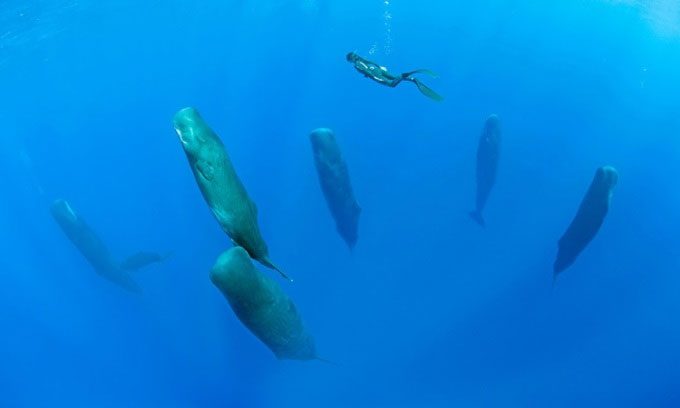Some marine mammals, such as dolphins, choose to sleep with one half of their brain, while sperm whales sleep upright in the depths of the ocean.
If marine mammals want to sleep, they cannot just close their eyes and drift off into the night, as they need to surface for air. They also cannot float on the water’s surface and fall asleep due to the risk of predators and heat loss, according to Live Science.

Sperm whales sleep upright for short periods. (Photo: Franco Banfi).
One solution is to stop activity in one half of the brain at a time. Known as unihemispheric slow-wave sleep, this is how marine mammals like dolphins rest in the vast ocean. “Unihemispheric slow-wave sleep is really beneficial for these animals because it allows them to maintain a low level of activity while still sleeping with one half of their brain at a time,” said Patrick Miller, a biologist at the University of St Andrews in the UK.
Dolphins are the most studied marine mammals capable of this type of sleep. Brain scans of captive dolphins show that while one hemisphere experiences slow-wave deep sleep, the other hemisphere remains awake, allowing the animal to sleep with one eye open. This type of sleep is quite common in the suborder Cetacea, a group of mammals that includes dolphins, whales, and porpoises. Many bird species also use unihemispheric sleep to rest while flying.
However, according to Miller, birds and dolphins use the half-brain sleep technique for different purposes. For example, in a flock of birds, many on the outer edge keep one eye open to watch for predators. Dolphins, on the other hand, do the opposite. When sleeping, they often keep the eye facing the rest of the pod open, likely to avoid becoming separated.
Not all species within the suborder Cetacea can sleep unihemispherically. Some species engage in bihemispheric sleep, where both hemispheres of the brain enter sleep like humans and most other mammals. “It’s really difficult to measure the brain activity of marine animals that you can’t catch, like sperm whales, blue whales, or humpback whales. In those cases, behavioral data is the best clue we have about their sleeping behavior,” Miller shared.
In such cases, researchers can tag animals to monitor their behavior. A 2008 study by Miller used tags on sperm whales (Physeter macrocephalus) to demonstrate that they sleep in the ocean for short intervals. Sperm whales dive close to the surface, slow down their swimming, then stop and sleep upright. Their vertical sleeping posture is likely due to a type of buoyant oil called spermaceti in their heads.
While sleeping, the entire pod of sperm whales positions their heads upward, near the surface of the sea. During this time, the animals are completely unresponsive, indicating they are in a form of deep sleep. However, sperm whales can only sleep underwater for about 20 minutes before needing to surface to breathe. After breathing, the sperm whale can dive back below the surface to rest further and may continue this behavior for up to 3.5 hours.
Northern elephant seals (Mirounga angustirostris) also sleep with both hemispheres in short intervals. A 2023 study by Jessica Kendall-Bar, a postdoctoral researcher at the Scripps Institution of Oceanography, University of California, San Diego, was the first to measure brain activity in marine sleeping mammals. Kendall-Bar and colleagues found that the seals dive to depths of about 300 meters. There, their brains slow down and enter rapid eye movement sleep. They flip over and swim in slow circles while continuing to sleep.
Due to the threat from predators, northern elephant seals limit their total sleeping time at sea to about two hours per day, making them among the least sleeping mammals.


















































